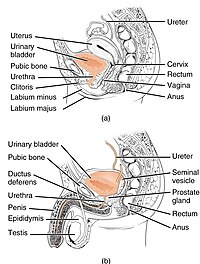
Photo from wikipedia
Lower urinary tract dysfunction (LUTD) is common and causes a spectrum of morbidity and decreased quality of life (QoL) for patients. LUTD can range from urinary retention to urge incontinence,… Click to show full abstract
Lower urinary tract dysfunction (LUTD) is common and causes a spectrum of morbidity and decreased quality of life (QoL) for patients. LUTD can range from urinary retention to urge incontinence, and includes a variety of syndromes, with the most common and widely recognized being overactive bladder (OAB). The classic treatments of LUTD and OAB comprise different strategies including behavioral therapies, medications and minimally invasive or invasive surgical procedures. Generally, once patients have tried behavioral modifications and oral medical therapy, and have not experienced adequate relief of their symptoms, the next step is to consider minimally invasive therapies. In the last two decades since FDA approval, sacral nerve stimulation (SNS) has become an accepted intervention, with increasing use and evidence of effectiveness for LUTD, specifically OAB and non-obstructive urinary retention. SNS has shown both objective and subjective improvement in voiding symptoms in several randomized controlled trials (RCTs) when compared to sham or standard medical therapy. The main limitations for more extensive use include relatively high cost, implantation of a device and possibly reoperation secondary to adverse events (AE). Percutaneous tibial nerve stimulation (PTNS) is a less invasive, less direct and less expensive method for neuromodulation, which has also shown effectiveness in several randomized and non-randomized trials, including comparable improvement rates to anticholinergics in OAB management. However, the efficacy of PTNS is only maintained for a short period after the stimulation is delivered. This technique has a much lower rate of AE compared to SNS, but with the inconvenience of weekly visits for stimulation, although implantable devices are on the horizon. In this article we review the mechanism of action, indications, effectiveness and complications related to SNS and PTNS therapy for LUTD.
Journal Title: Therapeutic Advances in Urology
Year Published: 2018
Link to full text (if available)
Share on Social Media: Sign Up to like & get
recommendations!